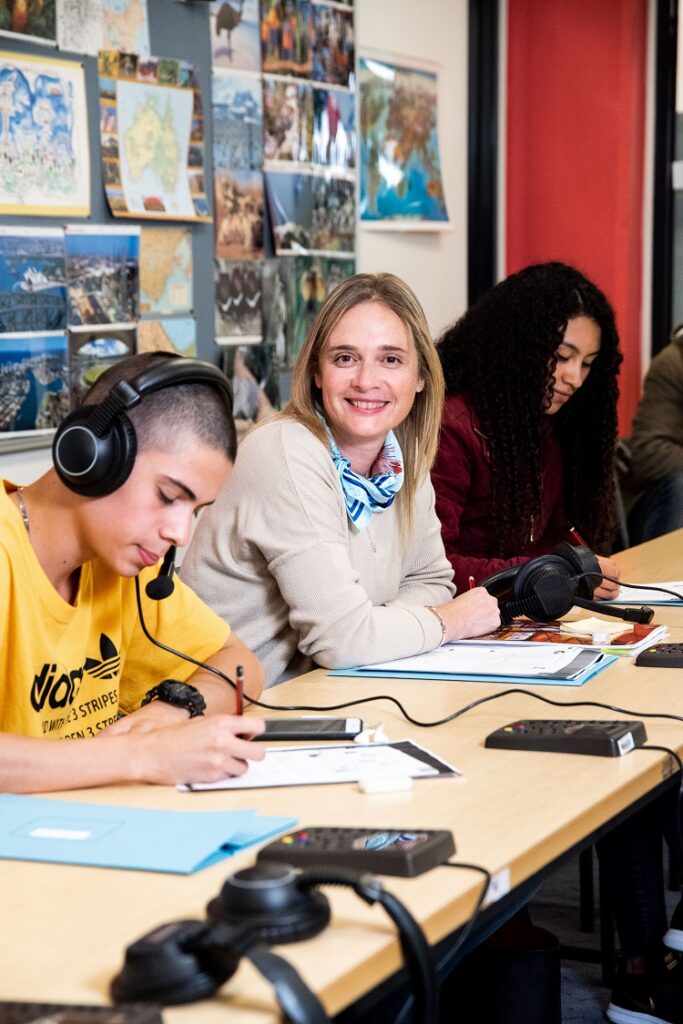Business continuity in response to COVID -19 – The Gordon Institute of TAFE
1) Evolution of the Delivery Model - The Journey to Virtual Learning
Facilitation model
The Gordon Institute of TAFE has encouraged teachers to think about their facilitation model. This includes the channels that they use e.g. email, Zoom, Gordon Online forums and the learning content that they use to assist learning; e.g. reading materials, student workbooks, asynchronous online discussions or webinars. The focus is on how to keep students engaged, how the teachers plan what they are going to do every lesson and how they provide ongoing support and feedback.
Virtual staff room
The education development team, set up a virtual staff room on Gordon Online. All teachers have access to this platform and there is a staff member online during the teaching day (9am-5pm) to assist with enquiries. There is also a self-help portal which where teachers are encouraged to have a look and ask questions, share ideas and learn how they can support their students.
The virtual staff room is the home for short videos, longer information clips and a running Q&A.
‘How to’ guides
The teachers’ essential toolkit (TET site) has ‘how to’ guides for Gordon Online and other helpful items that assist their work with remote learners. This can be viewed online or printed out.
Service catalogue
All requests, technical issues, enrolments and course creation requests are funnelled through a central point, through the service desk.
Learning materials
Our liaison librarians have worked on subject library guides to enhance them with a range of open source and free to use content that teachers can use with their students.
Supporting planning
The education development team has developed a handy planner for teachers to think about what they do in the classroom and how they may do that remotely (not a one size fits all.) This helps teachers think about how can they manage their students expectations, keep them engaged, keep them supported and most of all keep them learning.
2) New Approaches to Working with Industry
- The Gordon implemented Adobe Sign for varying contractual arrangements i.e. VET Delivered to Secondary Students (VETDSS), standard purchasing contracts and employer competency-based completion sign off for apprentice competencies.
- All meetings facilitated with secondary schools and industry partners via Zoom, WebEx and Teams replacing face to face style meetings.
- The Director of Education has facilitated online information sessions with employers to provide updates on delivery methodologies and impacts on apprentice completions.
- A letter was sent to all employer stakeholders (over 1,000) at the end of March 2020, explaining how the Gordon would be delivering training and assessment and provided them with details of how they could get in touch.
Some industry groups have been proactive in wishing to support our students by providing industry-standard learning resources and materials packs.


3) Student Support
Students have been contacted weekly through the Gordon’s online publication the Gordon Goss. Below are initiatives that have been put in place to support students.
Frequently asked questions – This link provides answers to questions that have been commonly asked. This information is on the student portal and is updated regularly. This is the key place to direct students as a first point of call. https://www.thegordon.edu.au/quick-links/special-notice-pages/learning-online-faqs.
Remote retention team (RRT) – A RRT has been established to support students at risk of withdrawing or falling behind (Email RRT@gordontafe.edu.au). It is not compulsory for teachers to use the remote retention team. Teachers may indeed continue to provide this support directly to students however, the team is here to help teachers to continue to support all of their students. The RRT assists students and liaises across the organisation to help. Teachers using this support service are provided with updates about the barriers identified and the potential actions to be taken to reduce these barriers for their individual students.
Laptop loans program – The Gordon has developed an extensive laptop loan system for students who do not have a laptop. This program is only for students who do not have access to a laptop, but with this device could continue their learning from a remote location. Students must have their own data to be able to loan a laptop.
On campus computer access – All campuses have computers available on site for students to utilise on campus. This is for students who do not have data.
Learning via correspondence – For students who are unable to learn using digital technologies, the Correspondence Learning project provides a paper based option. All Course materials are provided in printed form to the students. See FAQ’s for further detail.
Student hotline – A priority phone hotline has been established for students. This hotline number takes the incoming caller to the top of the call waiting cue. The frequently asked questions provide a great deal of information so this is the first place to look. However the hotline is available if students are unable to resolve their question via the FAQs and require priority assistance.
Resource / materials pick up and drop off support -Teachers are able to use the drop off and pick up service for large volumes of learning materials or for kits that are required by students to continue their learning. Teachers are to organise all of the goods themselves, however there is support at designated locations and designated times to coordinate the dissemination.
4) How staff are engaging in new ways of working.
Adaption of face-to-face (F2F) classroom delivery to remote /online platforms has been a major challenge for many program areas which has highlighted some major business improvement opportunities. Remote learning does require a level of understanding by teachers on how to use technology, which can be intimidating if they have low digital literacy.
Other concerns for teachers included the lack of connectedness for the student with the content of the course and how to keep students connected as a class group. Some teachers established online groups, outside of delivery class time, that helped create connectedness and a community feeling, limiting the sense of isolation. However, how we group our students also needs to consider capability, engagement, retention, value in terms of individual input and the importance of a positive learning experience regardless of the learning environment. Understanding how synchronous and asynchronous learning can occur in an online classroom has helped to clarify the delivery activities and build confidence in teachers and students on the learning outcomes.
Educational development in the virtual classroom – This virtual ‘practice’ staff room has been pivotal to the Gordon’s success in adapting the current course delivery to a remote learning environment in a tight timeframe. It also emphasises the importance of having a team that understands course delivery and compliance standards and can support an institute with designing and delivering a learning management system.
VET in Schools– The Gordon has been using Gordon Online – a Moodle based learning management system (LMS) since 2012. Our teachers have been working to transition the VET Delivered to Secondary Students (VETDSS) programs into a remote learning framework. This framework uses the LMS and has the secure functional capability to deliver services like video conferencing and chat groups where they are important to the curriculum and where the program manager and teacher deem them to be an appropriate learning tool. We also use the LMS for the sharing of files, video and text resources required for activities during the learning session. The LMS enables secure submission of assignment work, grading and feedback to students.
Remote learning tools – When remote learning is activated students and teachers can connect using a conferencing tool called Zoom. This system is capable of video and audio chat and has been embedded into Gordon Online. This enables teachers to deliver classes and check in with students to ensure they are understanding the delivery.
We have implemented a range of technology controls and teacher practice guidelines to appropriately secure this environment, these include;
- A completed privacy impact assessment;
- Application of all recommended security control protocols from the Victorian Government Cyber Unit;
- Limiting the Zoom environment to only use Australian servers and to not save any recordings; and
- Implementing clear guidelines for teachers including:
- The virtual classroom platform must never be used between the teacher and one individual student. A class must have a minimum of two students on the platform at any one time with the teacher;
- Teachers and students are expected to use an appropriate setting in their home when using the online platform and must follow online etiquette and be appropriately attired at all times when using the online platform/video streaming;
- Child safety which remains at the forefront of the educational experience
Staff have taken up Victorian Development Centre webinar places designed to inform and upskill their practices in the COVID-19 and remote learning environment.

